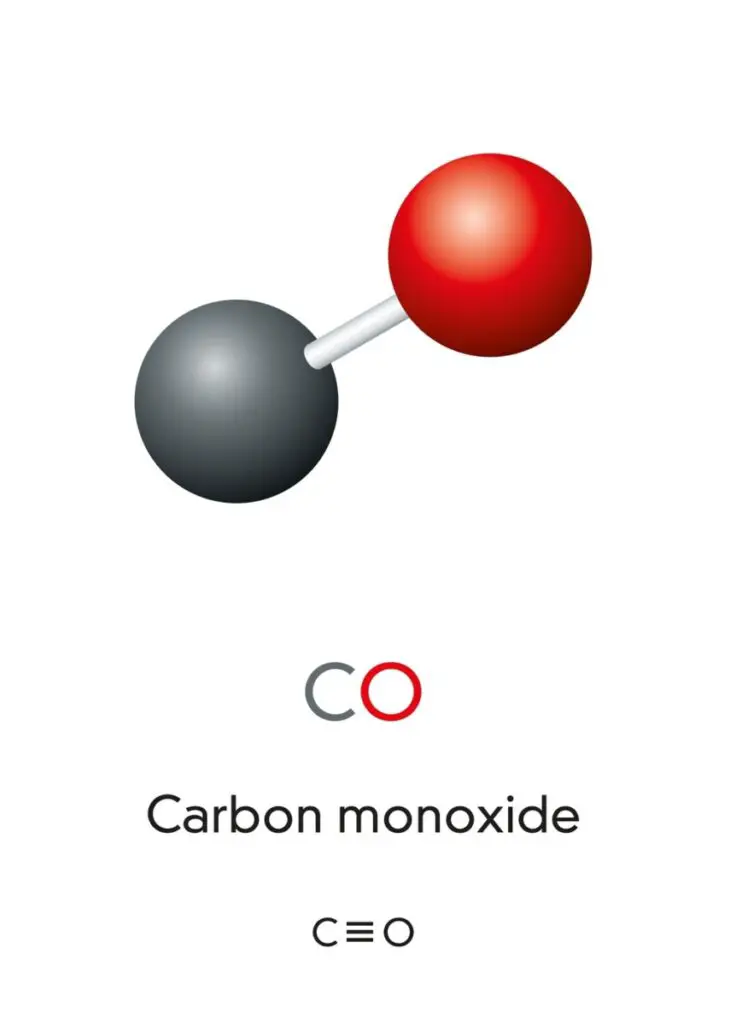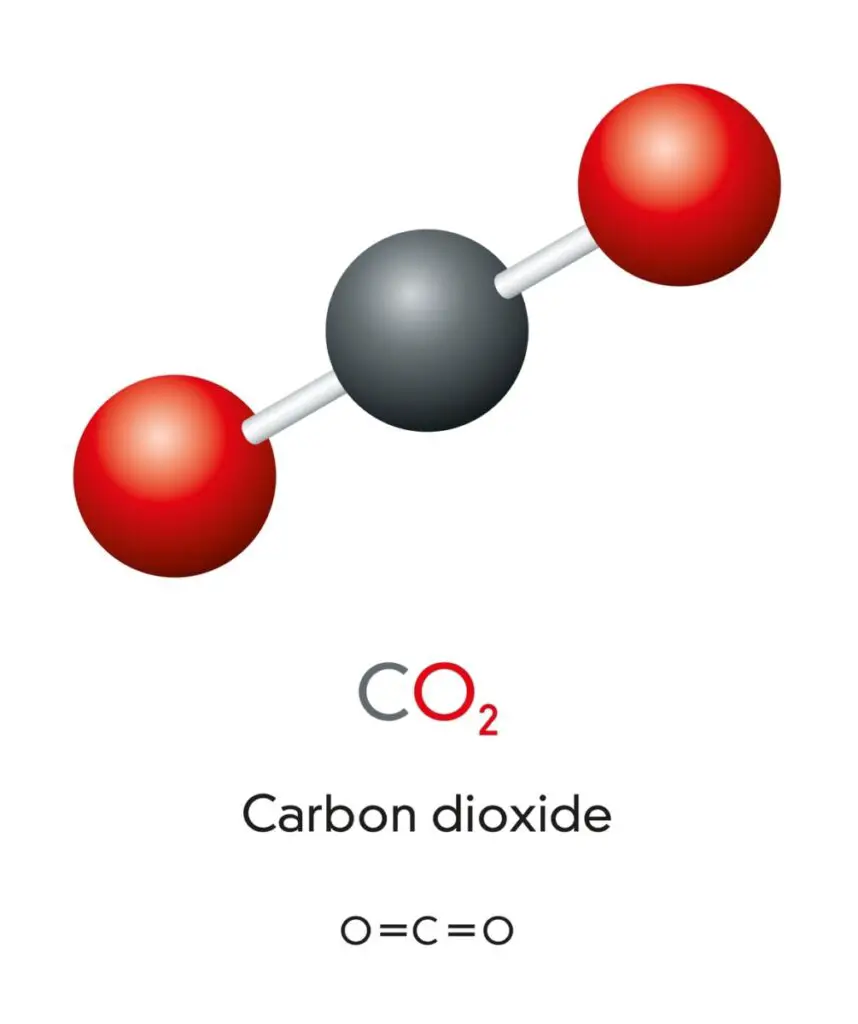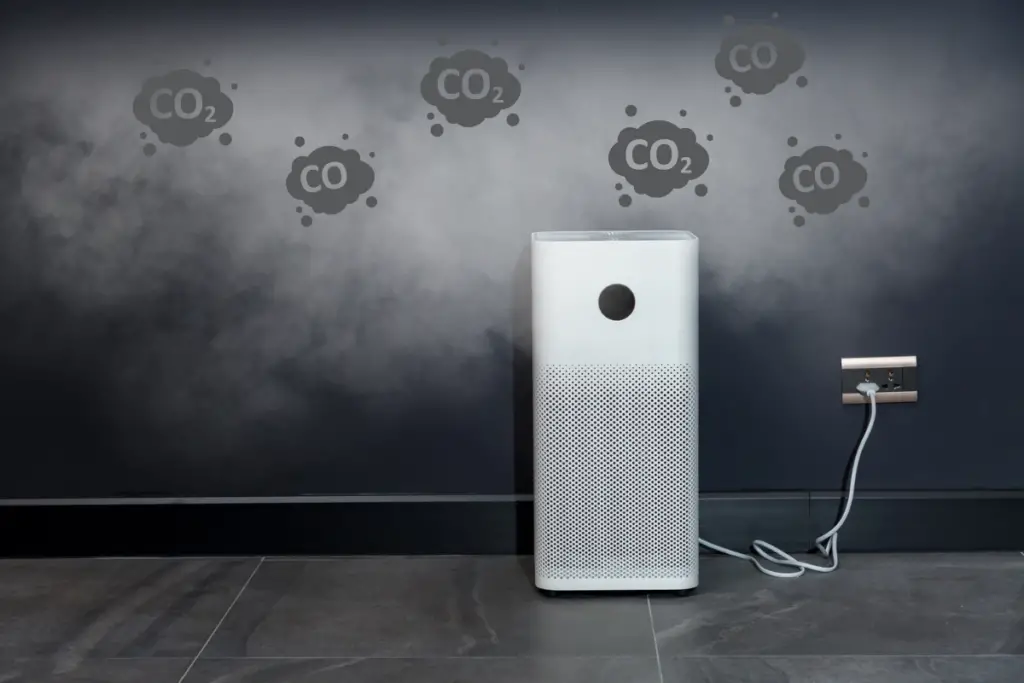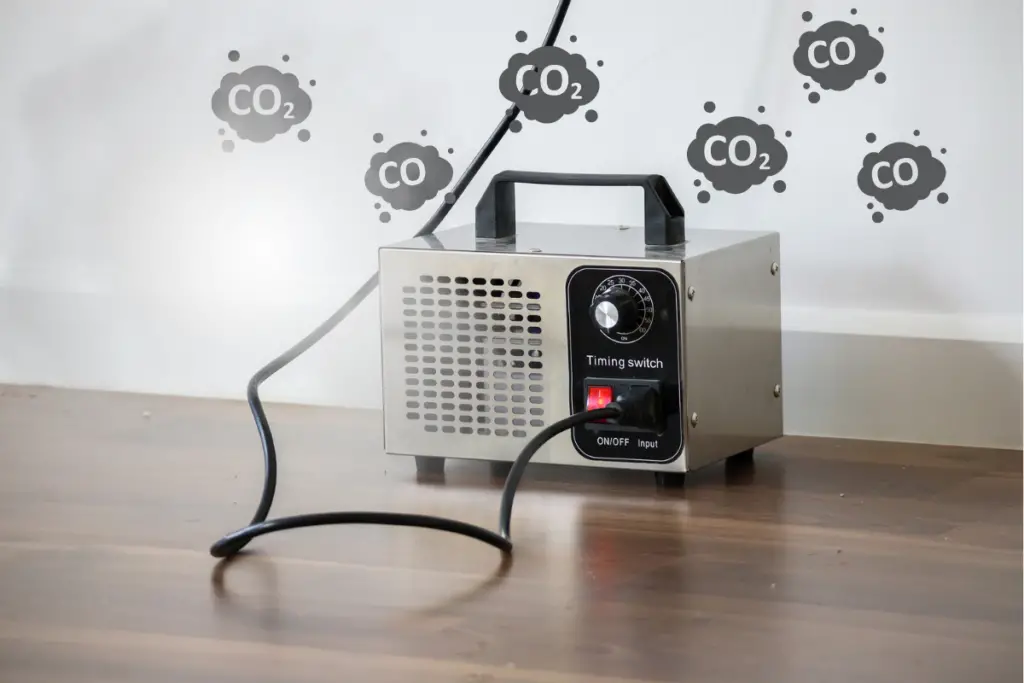Air purifiers are common household appliances that remove airborne particles, pathogens, and certain gases. But some people think they could be a source of toxic gases like carbon dioxide and carbon monoxide?
CO and CO2 are caused by lack of ventilation and incomplete combustion. Therefore, air purifiers cannot produce them. However, air purifiers are also incapable of filtering these gases from the air.
Carbon monoxide and carbon dioxide have various severe health implications. As a user, you should know if your air purifier is emitting these gases or successfully eliminating them from the environment. This article provides helpful information about these two gases and how they interact with air purifiers.
Carbon Monoxide

Carbon monoxide (CO) is a toxic gas that annually claims more than 400 American lives.
It constitutes 100 parts per billion (ppb) of Earth’s atmosphere and is a product of burning materials (incomplete thermal combustion).
Thus, fumes from trucks, cars, lanterns, stoves, fireplaces, or construction materials are primary CO gas sources in homes. Appliances like heaters, furnaces, HVAC units, etc., can also contribute to CO concentration due to malfunctioning.
Typically, 70 ppm of CO can cause headaches and nausea. However, concentrations above 150-200 ppm can prove lethal.
Carbon Monoxide Poisoning
CO poisoning is characterized by the onset of symptoms that occur upon inhalation of the gas. Here’s how it is caused:
- Typically, we breathe in oxygen which binds to RBCs (red blood cells).
- This oxygen is converted into energy and delivered to the body tissues.
- Hb (RBC protein that binds oxygen) has a 250 times higher affinity for CO; thus, when CO is inspired, it displaces oxygen and binds to RBCs.
- Low oxygen concentration in the body leads to energy depletion, which causes a series of unhealthy symptoms and eventual death.
Health Effects From Carbon Monoxide
Following are some major health complications of CO poisoning:
- Irreversible brain damage (anoxic brain injury)
- Heart failure
- Miscarriage
- Headache
- Fatigue
- Nausea
- Disorientation
- Death
Infants and children have higher breathing rates and are therefore more prone to CO poisoning. In addition, immunocompromised people or patients of cardiovascular and pulmonary disorders and pregnant women are also at higher risk of developing complications.
Detecting CO
CO is a colorless and odorless gas (hence the name “silent killer. CO monitors are often installed in homes with a high risk of gas leak (due to furnaces, heaters, construction materials, excessive fume production, etc.). These monitors have a sensor that measures CO levels and sets off an alarm to signal high gas levels.
Other than a carbon monoxide monitor, the following are some signs you should look out for if you suspect CO leak:
- Everyone around starts experiencing nausea, headache, and dizziness.
- Black or yellow powdery stains (also called soot stains) around furnaces and heating systems (responsible for the gas leak). This stain is a sign of incomplete combustion.
- Since many exhaust gases are produced and released along with CO, you can check for their smell.
Carbon Dioxide

CO2 comprises almost 0.04% of the atmosphere.
Depending on ventilation, CO2 concentration in homes can vary from 400 to 1000 ppm.
5000 ppm of CO2 can cause oxygen deprivation, but more than 40,000 ppm exposure can immediately lead to death.
CO2 is expelled into the air due to the natural breathing process. Other than this, volcano eruption, cigarette smoke, and material decomposition. Inadequate ventilation can also lead to the emission of CO2 from HVAC units, stoves, and fireplaces.
CO2 Toxicity
High CO2 levels in the air imply oxygen deprivation. Less oxygen supply leads to low energy levels, and vital organs like the brain and heart cease functioning.
Exposure to high levels of CO2 can cause respiratory arrest (patient stops breathing) within a minute.
CO2 Health Complications
Here are some significant health effects of CO2 toxicity:
- Drowsiness
- Headache
- Nausea
- Skin flushing
- Trouble concentrating
- Disorientation
- Hyperventilation
People with chronic anemia, cardiovascular disorders, or breathing problems (asthma, emphysema, etc.) are at more risk of CO2 toxicity.
Detecting CO2
CO2 levels over 1000 ppm are considered high. However, since the gas is colorless, and its sharp and acidic odor is often difficult to identify, it is generally difficult to know if it’s concentrated indoors.
Installing CO2 gas detectors is one way to detect their levels. As oxygen deprivation immediately causes headache, dizziness, and difficulty breathing, these symptoms indicate high CO2.
Can Air Purifiers Produce Carbon Monoxide and Carbon Dioxide?
Air purifiers filter out airborne contaminants and do not produce toxic gases like CO and CO2.
Here’s how air purifiers work:
- First, a rotating fan draws air inside the system.
- Air is circulated through the unit and passed through a series of filters like True HEPA, activated charcoal filter, UV bulb, and ionizers.
- Each filter traps a particular type of infiltrate.
- Purified air is then emitted into the room.
We have established that CO is caused by incomplete thermal combustion. While CO2 also forms during combustion when carbon from fossil fuels combines with oxygen atoms in the atmosphere. Since there is no burning/combustion involved in air purifiers, they do not produce these toxic gases.
Do Air Purifiers Remove Carbon Dioxide and Carbon Monoxide From The Air?

Air purifiers have filters like True HEPA filter, activated charcoal filter, UV bulb, ionizer, generic filter (with large pores), TiO2 filter, etc.
Out of all these, only activated charcoal filters can remove gases. However, they can only remove a small proportion of the CO2 and CO molecules in our air and are considered ineffective in filtering out any meaningful concentration.
Although researchers continue to investigate how carbon filters could be improved to remove CO2 and CO from our air.
Here’s how activated carbon filters work:
- Activated carbon filters are created by oxygenating and heating pure carbon.
- In the air purifier, gases react with carbon and stick (adsorb) to the filter surface.
- The gas molecules are then trapped inside the tiny filter pores.
This mechanism perfectly works for smoke, benzene, VOCs, and other nonpolar molecules. However, since CO2 and CO molecules are tiny, they pass through the pores (0.5 to 50 microns).
Another reason why carbon filters fail against CO is because of the gas’s polar nature. Polarity is a physical property of compounds and is calculated by measuring the difference in electronegativities (the tendency of an atom to bond with other atoms /molecules).
Non-polar tend to form bonds with other non-polar molecules. Therefore, non-polar activated carbon does not react with CO.
While some studies have found that air purifiers remove low amounts of CO2 and CO. However, given that both the gases are highly toxic, you cannot entirely rely on air purifiers for their elimination from the room.
Can Ozone Generators Remove CO and CO2?

Ozone generators are forms of air purifiers that employ ozone gas to eliminate airborne contaminants. Each molecule of ozone comprises three oxygen atoms. Since two oxygen atoms are required to form an oxygen molecule, the third atom (nascent oxygen) is highly reactive. It readily reacts with surrounding compounds, leaving behind a stable oxygen molecule.
This reaction changes the chemical composition of airborne contaminants, thus reducing their toxicity.
Ozone generators are primarily used to remove odors, mold, and mildew.
Although many manufacturers of ozone generators claim that the product can effectively make every chemical or gas harmless, research suggests otherwise. Studies found that while ozone can remove multiple odors from the indoor environment, it cannot react with all substances.
The reaction of ozone and CO was studied at room temperature in an experiment. Ozone was exposed to varying amounts of CO at different temperatures. It was concluded that the reaction between the gases was minimal and immeasurably slow at room temperature (at which ozone generators are used).
Similarly, current data on the reaction between ozone and CO2 also doesn’t support the idea of ozone generators being dependable for eliminating CO2.
Hazards of Using Ozone Generators
Even though the effects of ozone on CO and CO2 are still debatable, here’s why you should avoid using ozone generators even if their vendors claim them to be highly effective:
- Ozone generators can release various toxins as a product of the chemical reaction. For example, although ozone can remove carpet odors, its reaction results in aldehyde formation. Aldehydes can constrict the air tract, causing breathing problems; therefore, using ozone generators isn’t always beneficial.
- Ozone exposure can damage the respiratory tract, causing chest tightness, congestion, coughing, nausea, etc.
- The gas can exacerbate asthma symptoms.
- Ozone concentration of 50 ppm when exposed to someone for an hour is fatal.
Do Air Purifiers Release Toxins?
Air purifiers do not produce toxins like dust, debris, or chemicals. However, inadequate filtration (due to clogged filters, improper airflow, overheating, malfunction in rotating fan, etc.) can release airborne contaminants into the room along with air.
Air purifiers don’t produce any toxic compounds. They may, however, harbor and breed bacteria, mold, and fungi and release them later into the environment. This happens due to the lack of adequate cleaning and maintenance of the unit.
Air filters have a specific capacity beyond which they become saturated and do not remove any pollutants. When the filters are not cleaned and replaced regularly, they become clogged, enabling dust, debris, and pathogens to escape into the system.
While most of it is emitted into the room, some bacteria and pathogens can accumulate in any part of the air purifier. Their buildup facilitates breeding, and when released into the environment, they can cause toxicity.
How Do You Get Carbon Monoxide Out Of Your House?
Ventilation is the most crucial and practical step to air out CO from the house. Checking why the furnace (or other heating systems) leaked the gas is also crucial.
Here’s how you can remove CO out of your house:
- Ensure proper ventilation. CO concentration can only be removed indoors by higher relative levels of oxygen. Opening all windows and doors allows fresh air inside and helps air out CO.
- Turn off ACs and other appliances. CO can build up inside domestic appliances as they draw air inside and circulate it through the internal system.
- Fix the problem at the source. CO is always caused by incomplete combustion. It is essential to address the source of the leak to ensure no risk of re-exposure.
How Long Does It Take To Air Out Carbon Monoxide?
Typically, CO requires fifteen minutes to a few hours to dissipate. The time frame can exceed or reduce depending upon the gas concentration. Opening all windows and ensuring proper ventilation and fixing the source of the gas can help air it out faster.
CO also makes its way into the body by inhalation. Proper exposure to high levels of pure oxygen is needed to restore its level in the body. Oxygen masks are often used to ensure adequate flow of the gas. When provided fresh air, it takes around four to six hours to flush CO from a patient’s body thoroughly.
After oxygen therapy, blood tests are carried out to check for carboxyhemoglobin (Hb bound to CO).
